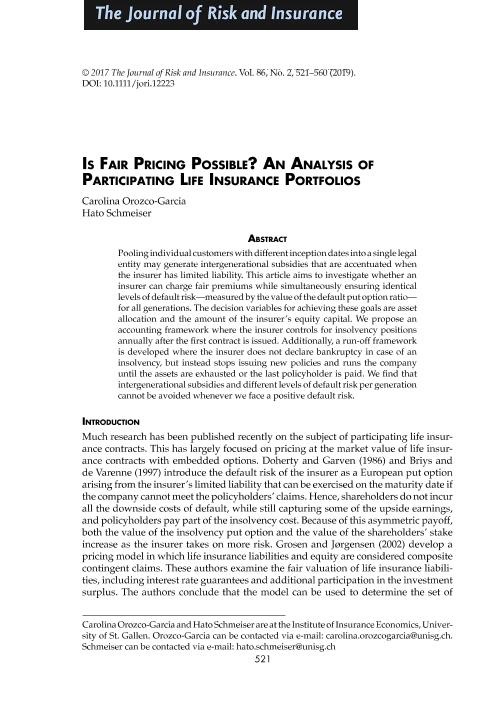Is fair pricing possible? an analysis of participating life insurance portfolios

Contenido multimedia no disponible por derechos de autor o por acceso restringido. Contacte con la institución para más información.
| Tag | 1 | 2 | Valor |
|---|---|---|---|
| LDR | 00000cab a2200000 4500 | ||
| 001 | MAP20190019682 | ||
| 003 | MAP | ||
| 005 | 20190625125335.0 | ||
| 008 | 190624e20190603usa|||p |0|||b|eng d | ||
| 040 | $aMAP$bspa$dMAP | ||
| 084 | $a341 | ||
| 100 | 1 | $0MAPA20190008594$aOrozco García, Carolina | |
| 245 | 0 | 0 | $aIs fair pricing possible? an analysis of participating life insurance portfolios$cCarolina Orozco García, Hato Schmeiser |
| 300 | $a40 p. | ||
| 520 | $aPooling individual customers with different inception dates into a single legal entity may generate intergenerational subsidies that are accentuated when the insurer has limited liability. This article aims to investigate whether an insurer can charge fair premiums while simultaneously ensuring identical levels of default riskmeasured by the value of the default put option ratio for all generations. The decision variables for achieving these goals are asset allocation and the amount of the insurer's equity capital. We propose an accounting framework where the insurer controls for insolvency positions annually after the first contract is issued. Additionally, a run-off framework is developed where the insurer does not declare bankruptcy in case of an insolvency, but instead stops issuing new policies and runs the company until the assets are exhausted or the last policyholder is paid. We find that intergenerational subsidies and different levels of default risk per generation cannot be avoided whenever we face a positive default risk. | ||
| 650 | 4 | $0MAPA20080583972$aCartera de seguros | |
| 650 | 4 | $0MAPA20080570590$aSeguro de vida | |
| 650 | 4 | $0MAPA20080586294$aMercado de seguros | |
| 650 | 4 | $0MAPA20080619640$aIncumplimiento de contrato | |
| 700 | 1 | $0MAPA20080147648$aSchmeiser, Hato | |
| 773 | 0 | $wMAP20077000727$tThe Journal of risk and insurance$dNueva York : The American Risk and Insurance Association, 1964-$x0022-4367$g03/06/2019 Volumen 86 Número 2 - junio 2019 , p. 521-560 |

